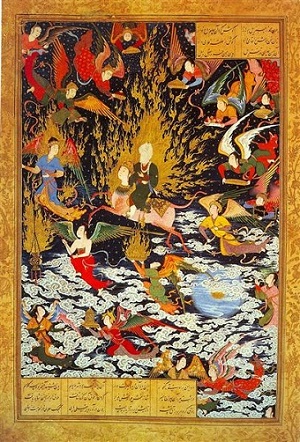COMPELLING TRUTH
The End Times According to Islam
By Robin Schumacher

Single Page/Printer Friendly

Nine years ago, then president of Iran Mahmoud Ahmadinejad stated in an interview that he experienced a supernatural experience during a speech he gave at the United Nations the previous year. Ahmadinejad claimed that he was bathed in a light from heaven at the outset of his talk, with the light remaining on him for the full length of the speech.
Ahmadinejad made a number of references during that U.N. speech to the "mighty Lord" who will hasten the emergence of "the promised one," the one who "will fill this world with justice and peace." [1] Exactly who was Ahmadinejad referring to? According to another speech he gave that same year, he saw his main mission to "pave the path for the glorious reappearance of Imam Mahdi, may Allah hasten his reappearance." [2]
CNN national security analyst Peter Bergen points out that ISIS has similar hopes based on their belief in Islamic prophecy. Believing that their actions hasten a supposed final battle at a small, obscure Syrian town named Dabiq between "Rome" and Islam (where the forces of true Islam triumph), Bergan notes: "ISIS members devoutly believe that they are fighting in a cosmic war in which they are on the side of good, which allows them to kill anyone they perceive to be standing in their way with no compunction. This is, of course, a serious delusion, but serious it is." [3]
A recent article by Graeme Wood in The Atlantic echoes Bergen's conclusions on ISIS' prophetically driven ideology and puts forward the idea that no threat will deter their current course of action: "That the Islamic State holds the imminent fulfillment of prophecy as a matter of dogma at least tells us the mettle of our opponent. It is ready to cheer its own near-obliteration, and to remain confident, even when surrounded, that it will receive divine succor if it stays true to the Prophetic model." [4]
What exactly does Islamic eschatology (the study of the end times) teach and how does it drive its adherents to commit atrocities like those carried out by ISIS?
Postmillennial Eschatology — Islam Style
The teaching that Christians must prepare the world for Christ before He comes and begins His earthly reign (called postmillennialism) is all but dead in Christianity. But that same mindset is very well alive in Islam.
For example, in 2006, Ahmadinejad urged his countrymen to prepare for the coming of the Mahdi (discussed in more detail below) by turning the country into a mighty and advanced Islamic society and by avoiding the corruption and excesses of the West. While sounding innocent, it is important to understand that part of the preparation has to do with the elimination of Islam's enemies and those who stand in the way of the Mahdi's return. Topping the list is the United States, and the chief enemy of Islam, Israel.
Islam's End of Days Countdown
Because Islam's end time prophecies are spread throughout the various Hadith traditions and not in the Koran itself, it can be difficult to accurately put together an event timetable for the Islamic end time portrayal. What follows is a broad overview of the Islamic eschatological timeline. [5]
Because Islam's teachings sometimes take their cues from the Bible, it is not surprising to find that a series of minor and major signs herald the end of the world. Common scriptural signs found in Islamic teaching include an increase in apostasy (conversion to Christianity) and false prophets, a rise in natural calamities, numerous wars and political corruption, and increased immorality.
As with Christianity, Islam has an antichrist figure, mentioned only in the Hadiths, called the Dajjal. Islam's evil one is a Jew with only one eye, with some traditions stating that he has "infidel" written across his forehead.
The Dajjal's purpose is to be deified, worshipped, and to reign (sound familiar?) Using a seemingly small army of 70,000 Jews, who are pictured as his main followers, coupled with 70,000 Tartars, the Dajjal conquers all the world except Mecca and Medina, with his rule lasting only forty days (although each day will be like a year) before it is cut short by the return of Jesus.
The Second Coming
Jesus (or Isa), who Islam says was not crucified, did not die, and was not resurrected (Sura 4:156-159), returns to end the Dajjal's reign. Jesus heads to Damascus where he confronts and kills the Dajjal, with the side benefit of the battle to the Muslims being the complete eradication of the Jewish people.
It should be noted that the above tradition is what Sunni Muslims believe will happen, while the Shiites instead hold that the Dajjal will fall at the hands of the Mahdi, who they say is the 12th Imam, empowered to work miracles, and their promised savior from the Dajjal.
After the Dajjal is disposed of by either Jesus or the Mahdi, it is at this point the invasion of Gog and Magog, who are presented as two nations having a vast army, occurs. Chronicled in the Koran (Sura 18 and 21) and Hadiths, they invade Israel and confront Jesus and his followers. The Islamic Jesus cries out in fear to Allah who defeats the large army with deadly insects, which are reminiscent of the locusts in Revelation 9.

Continue to Page Two
Image Credit: Sultan Muhammad; "The ascent of Muhammad to heaven"; 1543; Public Domain
comments powered by Disqus
Published 3-9-15

